Employee Turnover's Effect on Company Profitability: An ASX Study
VerifiedAdded on 2023/04/23
|31
|6557
|103
Report
AI Summary
This research report investigates the relationship between employee turnover and the profitability of companies listed on the Australian Securities Exchange (ASX). It examines data from 30 randomly selected companies to determine if a correlation exists between employee turnover rates and overall profitability. The study explores factors contributing to employee turnover, such as recruitment processes, employee motivation, and company culture, and their subsequent impact on a company's financial performance. The findings suggest that high employee turnover can negatively affect productivity and profitability due to increased recruitment costs, training expenses, and potential loss of clients and internal knowledge. The report concludes with recommendations for companies to improve employee retention strategies and minimize the adverse effects of turnover on their bottom line, emphasizing the importance of creating a supportive and engaging work environment.
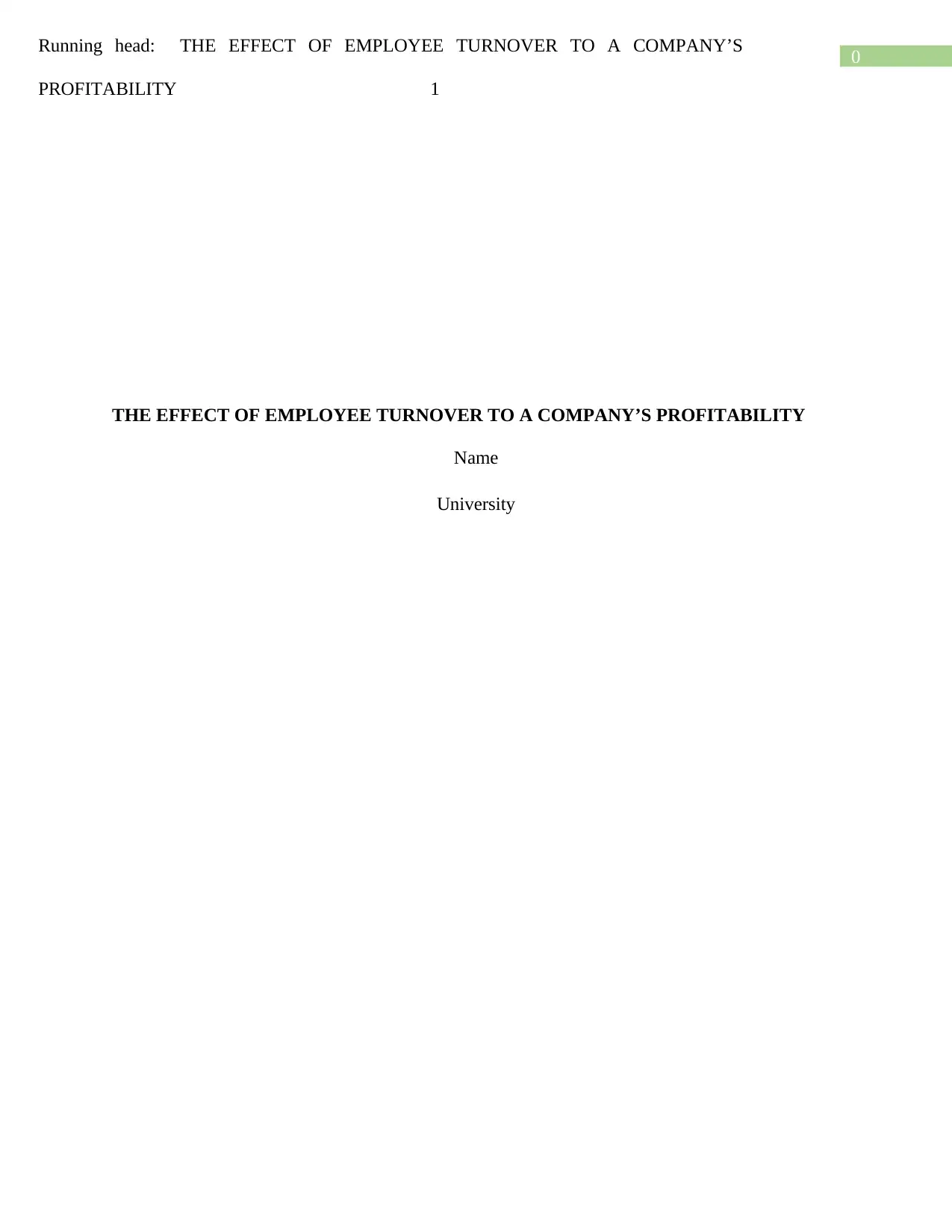
0
Running head: THE EFFECT OF EMPLOYEE TURNOVER TO A COMPANY’S
PROFITABILITY 1
THE EFFECT OF EMPLOYEE TURNOVER TO A COMPANY’S PROFITABILITY
Name
University
Running head: THE EFFECT OF EMPLOYEE TURNOVER TO A COMPANY’S
PROFITABILITY 1
THE EFFECT OF EMPLOYEE TURNOVER TO A COMPANY’S PROFITABILITY
Name
University
Paraphrase This Document
Need a fresh take? Get an instant paraphrase of this document with our AI Paraphraser
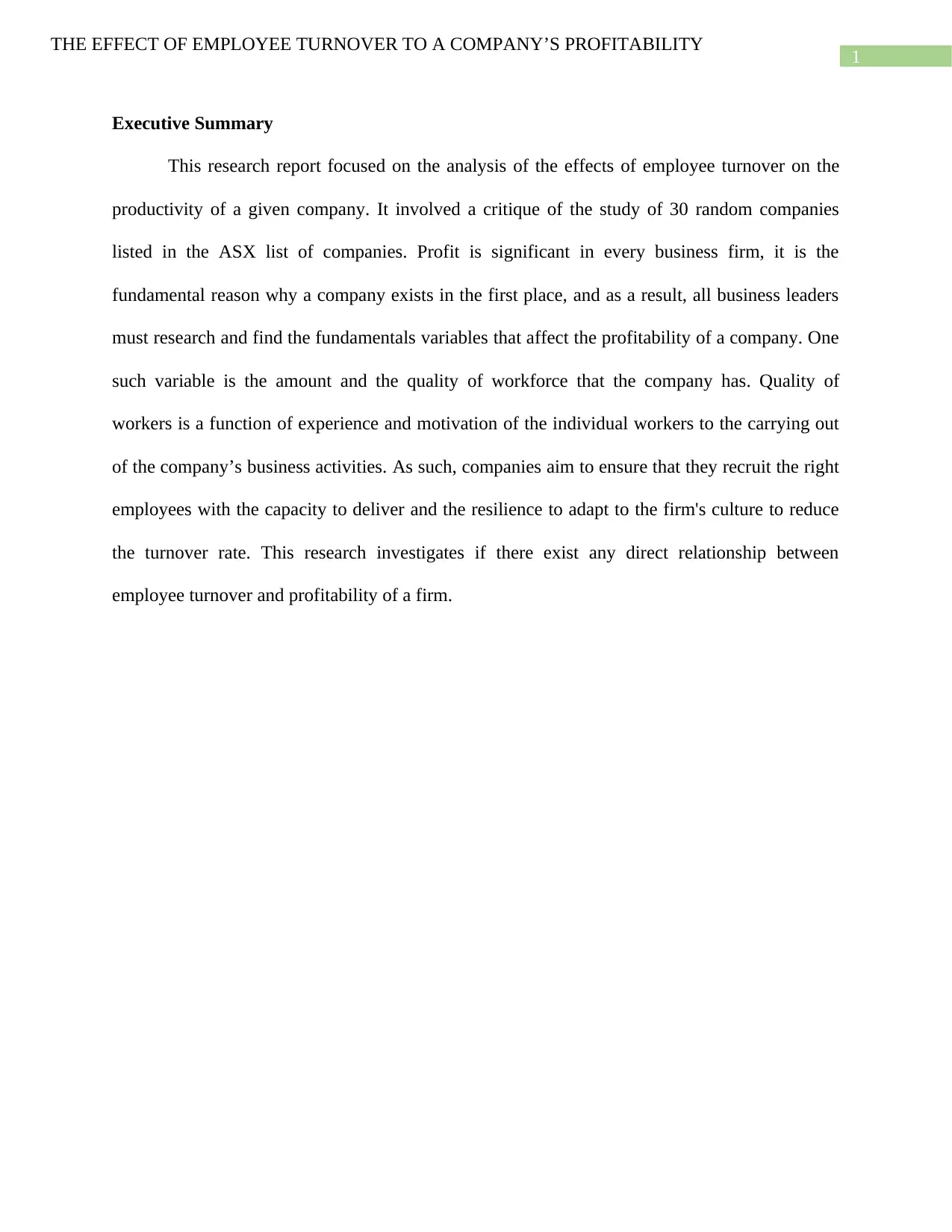
1
THE EFFECT OF EMPLOYEE TURNOVER TO A COMPANY’S PROFITABILITY
Executive Summary
This research report focused on the analysis of the effects of employee turnover on the
productivity of a given company. It involved a critique of the study of 30 random companies
listed in the ASX list of companies. Profit is significant in every business firm, it is the
fundamental reason why a company exists in the first place, and as a result, all business leaders
must research and find the fundamentals variables that affect the profitability of a company. One
such variable is the amount and the quality of workforce that the company has. Quality of
workers is a function of experience and motivation of the individual workers to the carrying out
of the company’s business activities. As such, companies aim to ensure that they recruit the right
employees with the capacity to deliver and the resilience to adapt to the firm's culture to reduce
the turnover rate. This research investigates if there exist any direct relationship between
employee turnover and profitability of a firm.
THE EFFECT OF EMPLOYEE TURNOVER TO A COMPANY’S PROFITABILITY
Executive Summary
This research report focused on the analysis of the effects of employee turnover on the
productivity of a given company. It involved a critique of the study of 30 random companies
listed in the ASX list of companies. Profit is significant in every business firm, it is the
fundamental reason why a company exists in the first place, and as a result, all business leaders
must research and find the fundamentals variables that affect the profitability of a company. One
such variable is the amount and the quality of workforce that the company has. Quality of
workers is a function of experience and motivation of the individual workers to the carrying out
of the company’s business activities. As such, companies aim to ensure that they recruit the right
employees with the capacity to deliver and the resilience to adapt to the firm's culture to reduce
the turnover rate. This research investigates if there exist any direct relationship between
employee turnover and profitability of a firm.
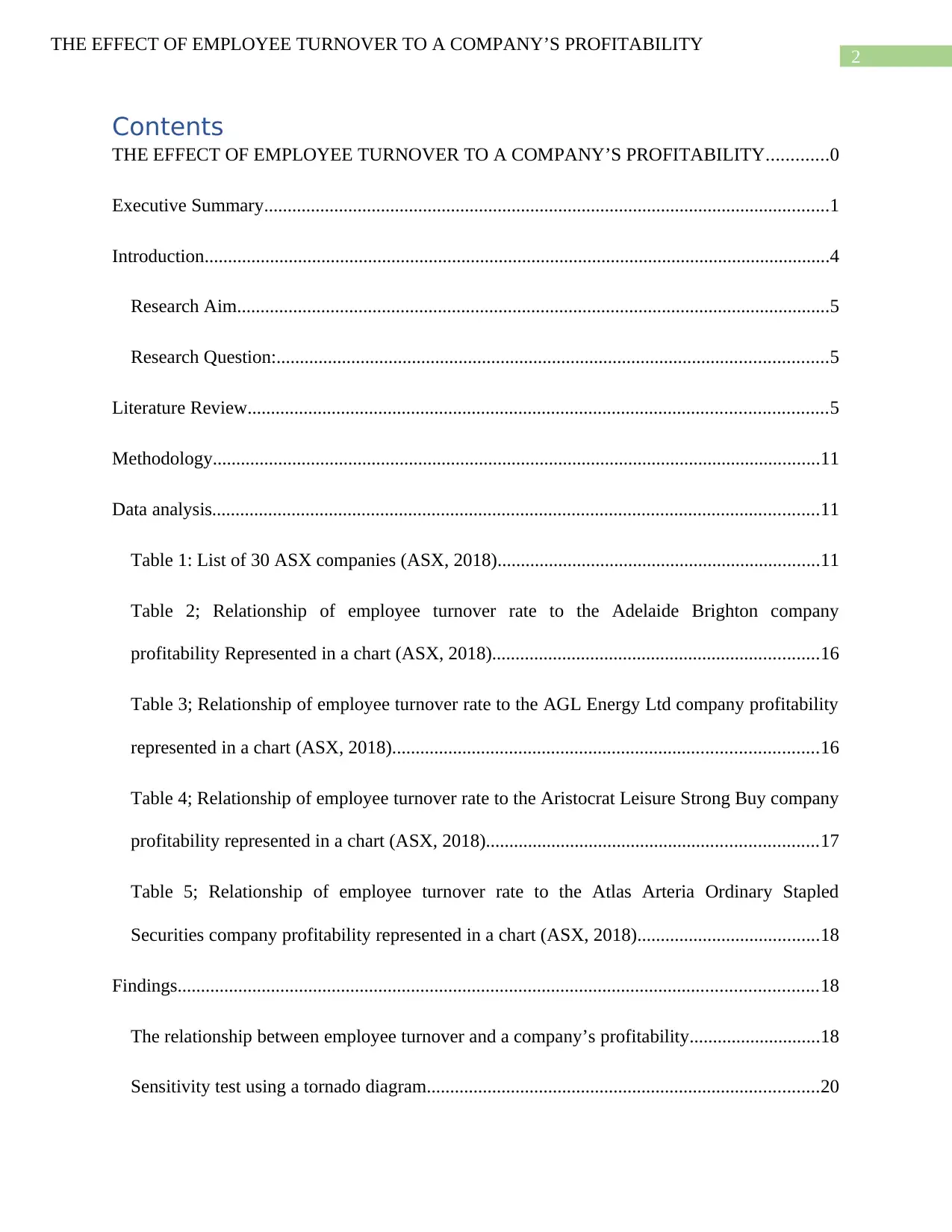
2
THE EFFECT OF EMPLOYEE TURNOVER TO A COMPANY’S PROFITABILITY
Contents
THE EFFECT OF EMPLOYEE TURNOVER TO A COMPANY’S PROFITABILITY.............0
Executive Summary.........................................................................................................................1
Introduction......................................................................................................................................4
Research Aim...............................................................................................................................5
Research Question:......................................................................................................................5
Literature Review............................................................................................................................5
Methodology..................................................................................................................................11
Data analysis..................................................................................................................................11
Table 1: List of 30 ASX companies (ASX, 2018).....................................................................11
Table 2; Relationship of employee turnover rate to the Adelaide Brighton company
profitability Represented in a chart (ASX, 2018)......................................................................16
Table 3; Relationship of employee turnover rate to the AGL Energy Ltd company profitability
represented in a chart (ASX, 2018)...........................................................................................16
Table 4; Relationship of employee turnover rate to the Aristocrat Leisure Strong Buy company
profitability represented in a chart (ASX, 2018).......................................................................17
Table 5; Relationship of employee turnover rate to the Atlas Arteria Ordinary Stapled
Securities company profitability represented in a chart (ASX, 2018).......................................18
Findings.........................................................................................................................................18
The relationship between employee turnover and a company’s profitability............................18
Sensitivity test using a tornado diagram....................................................................................20
THE EFFECT OF EMPLOYEE TURNOVER TO A COMPANY’S PROFITABILITY
Contents
THE EFFECT OF EMPLOYEE TURNOVER TO A COMPANY’S PROFITABILITY.............0
Executive Summary.........................................................................................................................1
Introduction......................................................................................................................................4
Research Aim...............................................................................................................................5
Research Question:......................................................................................................................5
Literature Review............................................................................................................................5
Methodology..................................................................................................................................11
Data analysis..................................................................................................................................11
Table 1: List of 30 ASX companies (ASX, 2018).....................................................................11
Table 2; Relationship of employee turnover rate to the Adelaide Brighton company
profitability Represented in a chart (ASX, 2018)......................................................................16
Table 3; Relationship of employee turnover rate to the AGL Energy Ltd company profitability
represented in a chart (ASX, 2018)...........................................................................................16
Table 4; Relationship of employee turnover rate to the Aristocrat Leisure Strong Buy company
profitability represented in a chart (ASX, 2018).......................................................................17
Table 5; Relationship of employee turnover rate to the Atlas Arteria Ordinary Stapled
Securities company profitability represented in a chart (ASX, 2018).......................................18
Findings.........................................................................................................................................18
The relationship between employee turnover and a company’s profitability............................18
Sensitivity test using a tornado diagram....................................................................................20
⊘ This is a preview!⊘
Do you want full access?
Subscribe today to unlock all pages.

Trusted by 1+ million students worldwide
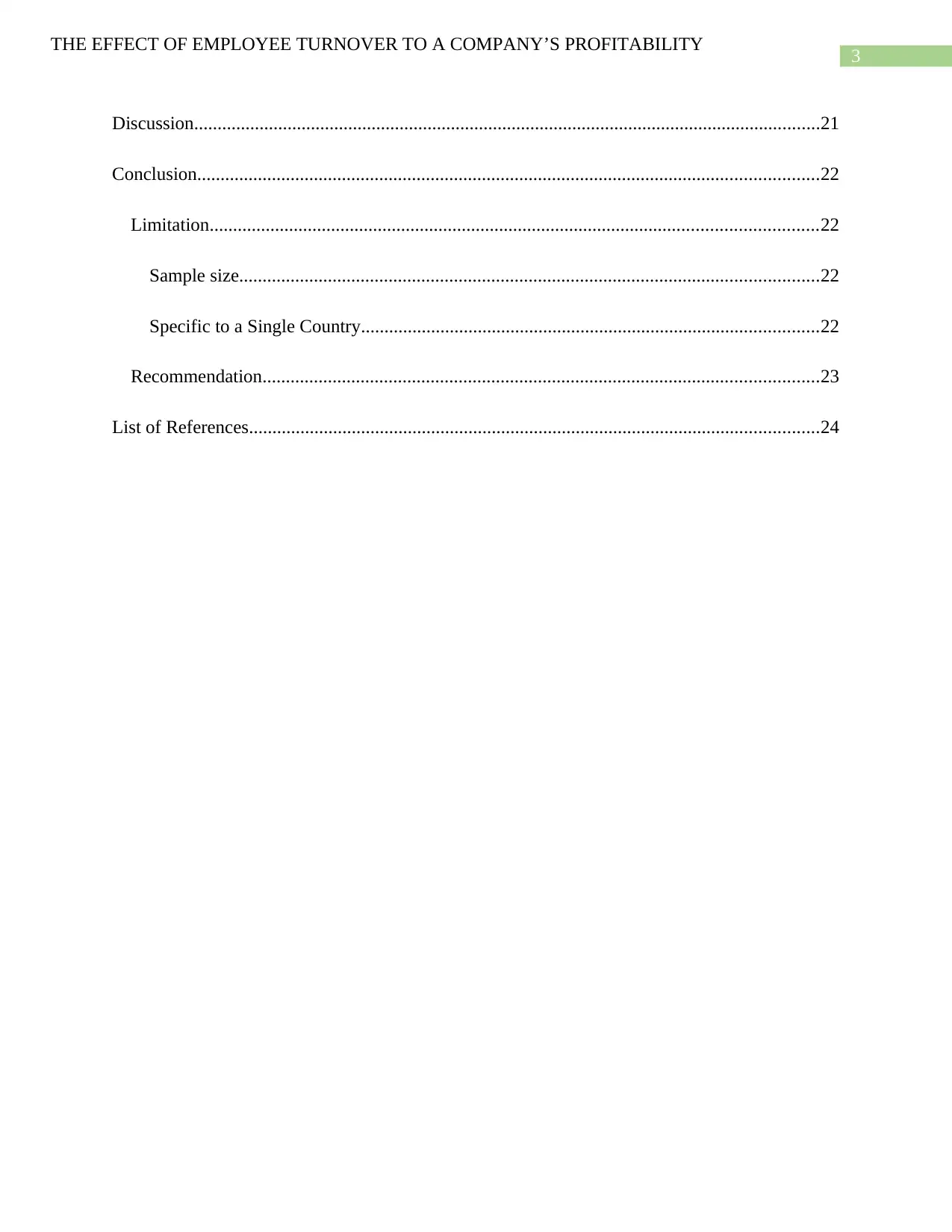
3
THE EFFECT OF EMPLOYEE TURNOVER TO A COMPANY’S PROFITABILITY
Discussion......................................................................................................................................21
Conclusion.....................................................................................................................................22
Limitation..................................................................................................................................22
Sample size............................................................................................................................22
Specific to a Single Country..................................................................................................22
Recommendation.......................................................................................................................23
List of References..........................................................................................................................24
THE EFFECT OF EMPLOYEE TURNOVER TO A COMPANY’S PROFITABILITY
Discussion......................................................................................................................................21
Conclusion.....................................................................................................................................22
Limitation..................................................................................................................................22
Sample size............................................................................................................................22
Specific to a Single Country..................................................................................................22
Recommendation.......................................................................................................................23
List of References..........................................................................................................................24
Paraphrase This Document
Need a fresh take? Get an instant paraphrase of this document with our AI Paraphraser
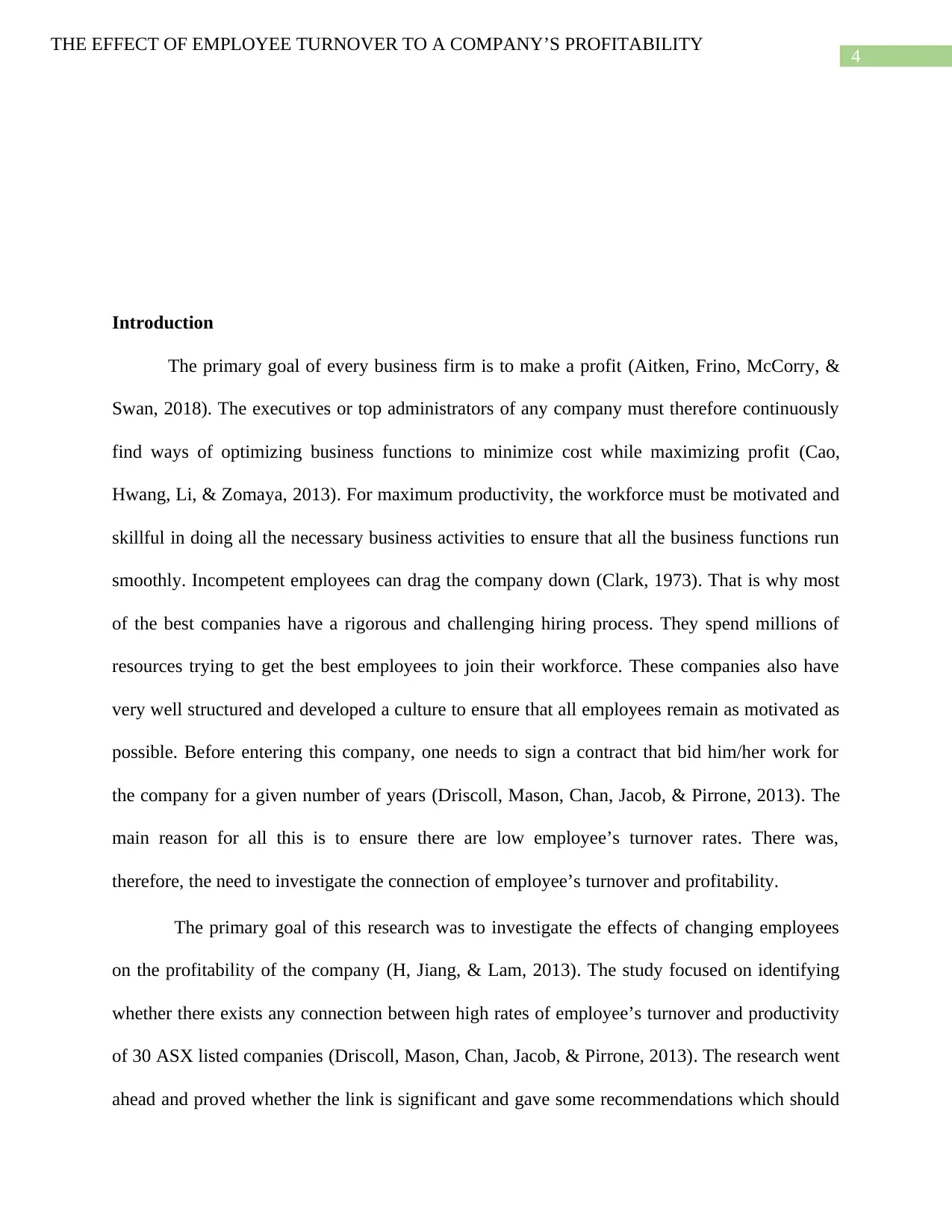
4
THE EFFECT OF EMPLOYEE TURNOVER TO A COMPANY’S PROFITABILITY
Introduction
The primary goal of every business firm is to make a profit (Aitken, Frino, McCorry, &
Swan, 2018). The executives or top administrators of any company must therefore continuously
find ways of optimizing business functions to minimize cost while maximizing profit (Cao,
Hwang, Li, & Zomaya, 2013). For maximum productivity, the workforce must be motivated and
skillful in doing all the necessary business activities to ensure that all the business functions run
smoothly. Incompetent employees can drag the company down (Clark, 1973). That is why most
of the best companies have a rigorous and challenging hiring process. They spend millions of
resources trying to get the best employees to join their workforce. These companies also have
very well structured and developed a culture to ensure that all employees remain as motivated as
possible. Before entering this company, one needs to sign a contract that bid him/her work for
the company for a given number of years (Driscoll, Mason, Chan, Jacob, & Pirrone, 2013). The
main reason for all this is to ensure there are low employee’s turnover rates. There was,
therefore, the need to investigate the connection of employee’s turnover and profitability.
The primary goal of this research was to investigate the effects of changing employees
on the profitability of the company (H, Jiang, & Lam, 2013). The study focused on identifying
whether there exists any connection between high rates of employee’s turnover and productivity
of 30 ASX listed companies (Driscoll, Mason, Chan, Jacob, & Pirrone, 2013). The research went
ahead and proved whether the link is significant and gave some recommendations which should
THE EFFECT OF EMPLOYEE TURNOVER TO A COMPANY’S PROFITABILITY
Introduction
The primary goal of every business firm is to make a profit (Aitken, Frino, McCorry, &
Swan, 2018). The executives or top administrators of any company must therefore continuously
find ways of optimizing business functions to minimize cost while maximizing profit (Cao,
Hwang, Li, & Zomaya, 2013). For maximum productivity, the workforce must be motivated and
skillful in doing all the necessary business activities to ensure that all the business functions run
smoothly. Incompetent employees can drag the company down (Clark, 1973). That is why most
of the best companies have a rigorous and challenging hiring process. They spend millions of
resources trying to get the best employees to join their workforce. These companies also have
very well structured and developed a culture to ensure that all employees remain as motivated as
possible. Before entering this company, one needs to sign a contract that bid him/her work for
the company for a given number of years (Driscoll, Mason, Chan, Jacob, & Pirrone, 2013). The
main reason for all this is to ensure there are low employee’s turnover rates. There was,
therefore, the need to investigate the connection of employee’s turnover and profitability.
The primary goal of this research was to investigate the effects of changing employees
on the profitability of the company (H, Jiang, & Lam, 2013). The study focused on identifying
whether there exists any connection between high rates of employee’s turnover and productivity
of 30 ASX listed companies (Driscoll, Mason, Chan, Jacob, & Pirrone, 2013). The research went
ahead and proved whether the link is significant and gave some recommendations which should
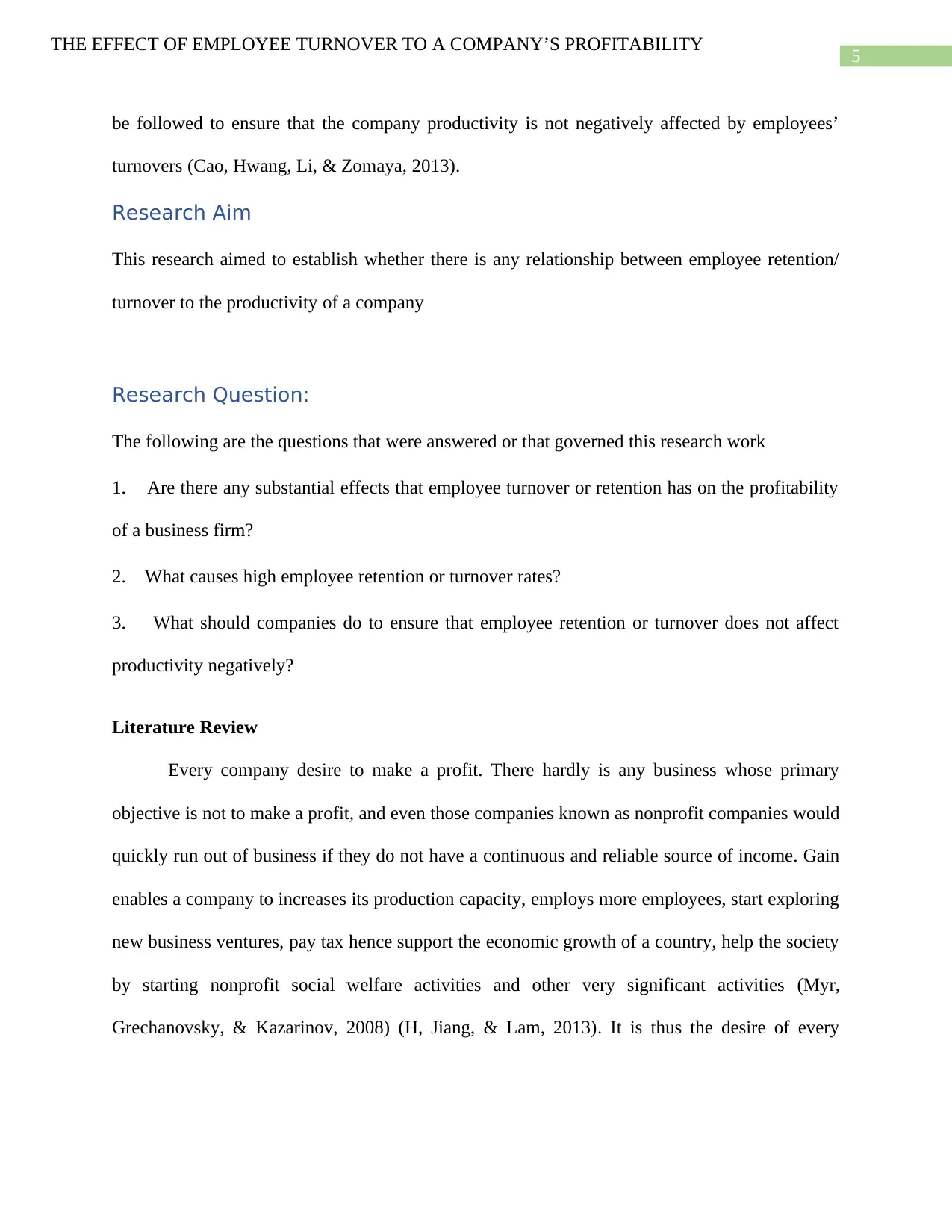
5
THE EFFECT OF EMPLOYEE TURNOVER TO A COMPANY’S PROFITABILITY
be followed to ensure that the company productivity is not negatively affected by employees’
turnovers (Cao, Hwang, Li, & Zomaya, 2013).
Research Aim
This research aimed to establish whether there is any relationship between employee retention/
turnover to the productivity of a company
Research Question:
The following are the questions that were answered or that governed this research work
1. Are there any substantial effects that employee turnover or retention has on the profitability
of a business firm?
2. What causes high employee retention or turnover rates?
3. What should companies do to ensure that employee retention or turnover does not affect
productivity negatively?
Literature Review
Every company desire to make a profit. There hardly is any business whose primary
objective is not to make a profit, and even those companies known as nonprofit companies would
quickly run out of business if they do not have a continuous and reliable source of income. Gain
enables a company to increases its production capacity, employs more employees, start exploring
new business ventures, pay tax hence support the economic growth of a country, help the society
by starting nonprofit social welfare activities and other very significant activities (Myr,
Grechanovsky, & Kazarinov, 2008) (H, Jiang, & Lam, 2013). It is thus the desire of every
THE EFFECT OF EMPLOYEE TURNOVER TO A COMPANY’S PROFITABILITY
be followed to ensure that the company productivity is not negatively affected by employees’
turnovers (Cao, Hwang, Li, & Zomaya, 2013).
Research Aim
This research aimed to establish whether there is any relationship between employee retention/
turnover to the productivity of a company
Research Question:
The following are the questions that were answered or that governed this research work
1. Are there any substantial effects that employee turnover or retention has on the profitability
of a business firm?
2. What causes high employee retention or turnover rates?
3. What should companies do to ensure that employee retention or turnover does not affect
productivity negatively?
Literature Review
Every company desire to make a profit. There hardly is any business whose primary
objective is not to make a profit, and even those companies known as nonprofit companies would
quickly run out of business if they do not have a continuous and reliable source of income. Gain
enables a company to increases its production capacity, employs more employees, start exploring
new business ventures, pay tax hence support the economic growth of a country, help the society
by starting nonprofit social welfare activities and other very significant activities (Myr,
Grechanovsky, & Kazarinov, 2008) (H, Jiang, & Lam, 2013). It is thus the desire of every
⊘ This is a preview!⊘
Do you want full access?
Subscribe today to unlock all pages.

Trusted by 1+ million students worldwide
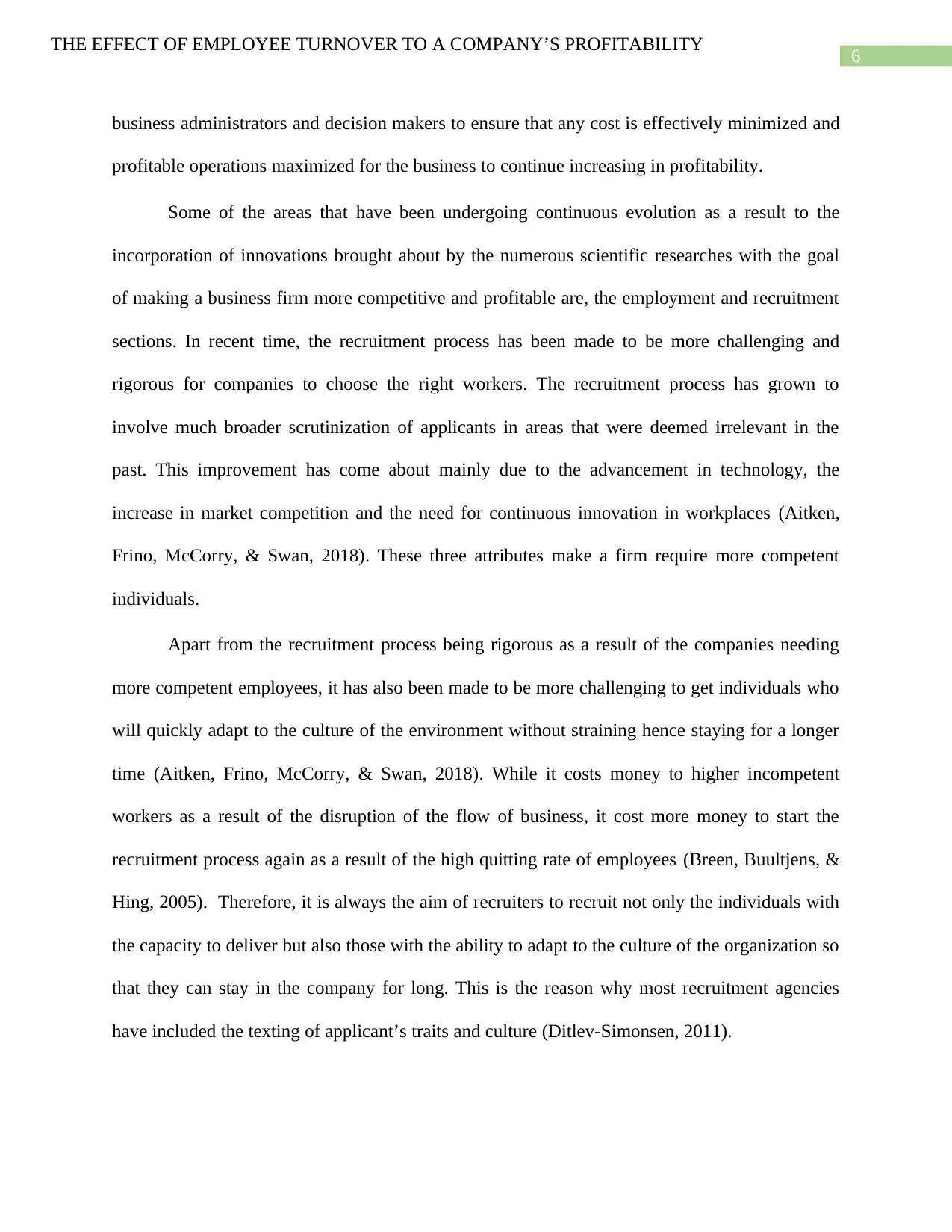
6
THE EFFECT OF EMPLOYEE TURNOVER TO A COMPANY’S PROFITABILITY
business administrators and decision makers to ensure that any cost is effectively minimized and
profitable operations maximized for the business to continue increasing in profitability.
Some of the areas that have been undergoing continuous evolution as a result to the
incorporation of innovations brought about by the numerous scientific researches with the goal
of making a business firm more competitive and profitable are, the employment and recruitment
sections. In recent time, the recruitment process has been made to be more challenging and
rigorous for companies to choose the right workers. The recruitment process has grown to
involve much broader scrutinization of applicants in areas that were deemed irrelevant in the
past. This improvement has come about mainly due to the advancement in technology, the
increase in market competition and the need for continuous innovation in workplaces (Aitken,
Frino, McCorry, & Swan, 2018). These three attributes make a firm require more competent
individuals.
Apart from the recruitment process being rigorous as a result of the companies needing
more competent employees, it has also been made to be more challenging to get individuals who
will quickly adapt to the culture of the environment without straining hence staying for a longer
time (Aitken, Frino, McCorry, & Swan, 2018). While it costs money to higher incompetent
workers as a result of the disruption of the flow of business, it cost more money to start the
recruitment process again as a result of the high quitting rate of employees (Breen, Buultjens, &
Hing, 2005). Therefore, it is always the aim of recruiters to recruit not only the individuals with
the capacity to deliver but also those with the ability to adapt to the culture of the organization so
that they can stay in the company for long. This is the reason why most recruitment agencies
have included the texting of applicant’s traits and culture (Ditlev-Simonsen, 2011).
THE EFFECT OF EMPLOYEE TURNOVER TO A COMPANY’S PROFITABILITY
business administrators and decision makers to ensure that any cost is effectively minimized and
profitable operations maximized for the business to continue increasing in profitability.
Some of the areas that have been undergoing continuous evolution as a result to the
incorporation of innovations brought about by the numerous scientific researches with the goal
of making a business firm more competitive and profitable are, the employment and recruitment
sections. In recent time, the recruitment process has been made to be more challenging and
rigorous for companies to choose the right workers. The recruitment process has grown to
involve much broader scrutinization of applicants in areas that were deemed irrelevant in the
past. This improvement has come about mainly due to the advancement in technology, the
increase in market competition and the need for continuous innovation in workplaces (Aitken,
Frino, McCorry, & Swan, 2018). These three attributes make a firm require more competent
individuals.
Apart from the recruitment process being rigorous as a result of the companies needing
more competent employees, it has also been made to be more challenging to get individuals who
will quickly adapt to the culture of the environment without straining hence staying for a longer
time (Aitken, Frino, McCorry, & Swan, 2018). While it costs money to higher incompetent
workers as a result of the disruption of the flow of business, it cost more money to start the
recruitment process again as a result of the high quitting rate of employees (Breen, Buultjens, &
Hing, 2005). Therefore, it is always the aim of recruiters to recruit not only the individuals with
the capacity to deliver but also those with the ability to adapt to the culture of the organization so
that they can stay in the company for long. This is the reason why most recruitment agencies
have included the texting of applicant’s traits and culture (Ditlev-Simonsen, 2011).
Paraphrase This Document
Need a fresh take? Get an instant paraphrase of this document with our AI Paraphraser
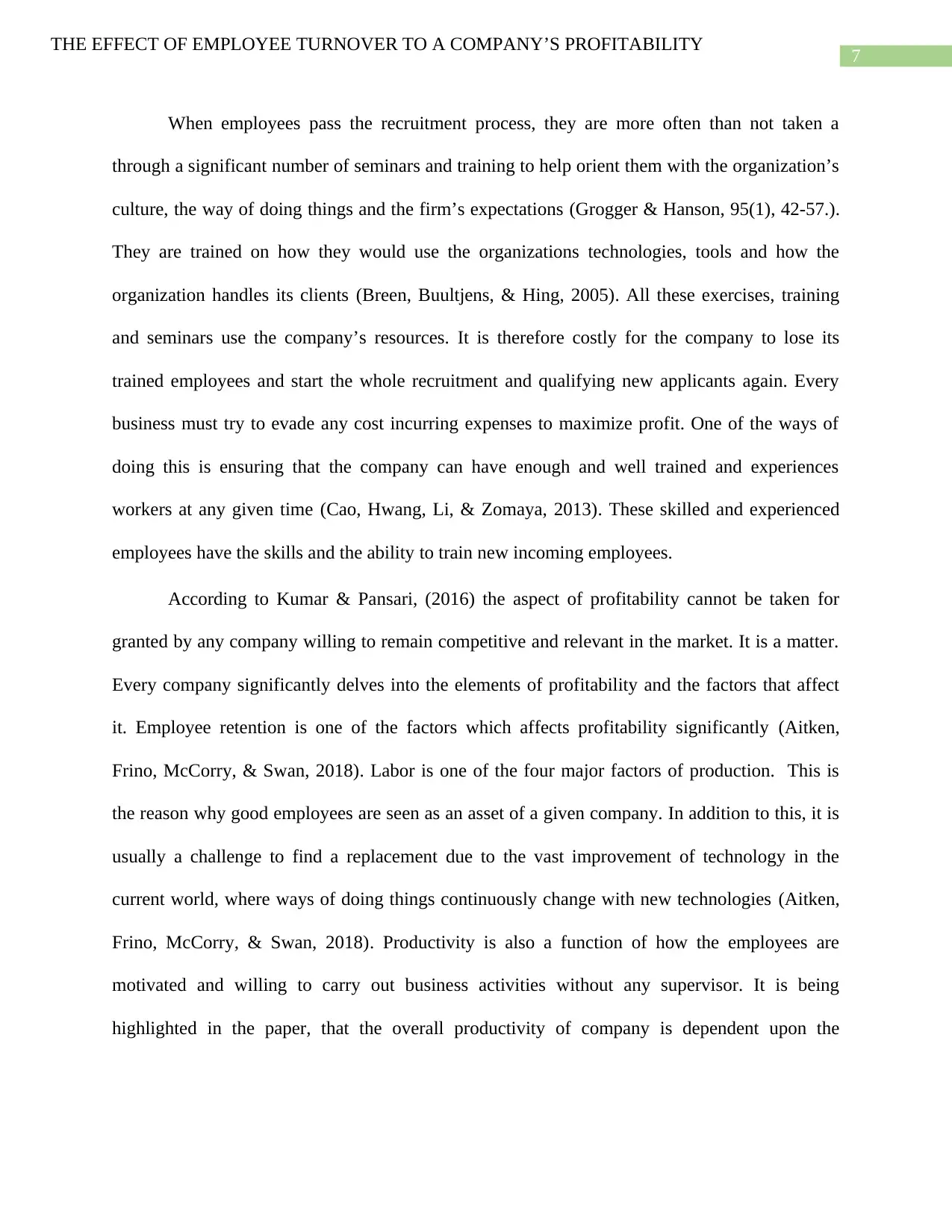
7
THE EFFECT OF EMPLOYEE TURNOVER TO A COMPANY’S PROFITABILITY
When employees pass the recruitment process, they are more often than not taken a
through a significant number of seminars and training to help orient them with the organization’s
culture, the way of doing things and the firm’s expectations (Grogger & Hanson, 95(1), 42-57.).
They are trained on how they would use the organizations technologies, tools and how the
organization handles its clients (Breen, Buultjens, & Hing, 2005). All these exercises, training
and seminars use the company’s resources. It is therefore costly for the company to lose its
trained employees and start the whole recruitment and qualifying new applicants again. Every
business must try to evade any cost incurring expenses to maximize profit. One of the ways of
doing this is ensuring that the company can have enough and well trained and experiences
workers at any given time (Cao, Hwang, Li, & Zomaya, 2013). These skilled and experienced
employees have the skills and the ability to train new incoming employees.
According to Kumar & Pansari, (2016) the aspect of profitability cannot be taken for
granted by any company willing to remain competitive and relevant in the market. It is a matter.
Every company significantly delves into the elements of profitability and the factors that affect
it. Employee retention is one of the factors which affects profitability significantly (Aitken,
Frino, McCorry, & Swan, 2018). Labor is one of the four major factors of production. This is
the reason why good employees are seen as an asset of a given company. In addition to this, it is
usually a challenge to find a replacement due to the vast improvement of technology in the
current world, where ways of doing things continuously change with new technologies (Aitken,
Frino, McCorry, & Swan, 2018). Productivity is also a function of how the employees are
motivated and willing to carry out business activities without any supervisor. It is being
highlighted in the paper, that the overall productivity of company is dependent upon the
THE EFFECT OF EMPLOYEE TURNOVER TO A COMPANY’S PROFITABILITY
When employees pass the recruitment process, they are more often than not taken a
through a significant number of seminars and training to help orient them with the organization’s
culture, the way of doing things and the firm’s expectations (Grogger & Hanson, 95(1), 42-57.).
They are trained on how they would use the organizations technologies, tools and how the
organization handles its clients (Breen, Buultjens, & Hing, 2005). All these exercises, training
and seminars use the company’s resources. It is therefore costly for the company to lose its
trained employees and start the whole recruitment and qualifying new applicants again. Every
business must try to evade any cost incurring expenses to maximize profit. One of the ways of
doing this is ensuring that the company can have enough and well trained and experiences
workers at any given time (Cao, Hwang, Li, & Zomaya, 2013). These skilled and experienced
employees have the skills and the ability to train new incoming employees.
According to Kumar & Pansari, (2016) the aspect of profitability cannot be taken for
granted by any company willing to remain competitive and relevant in the market. It is a matter.
Every company significantly delves into the elements of profitability and the factors that affect
it. Employee retention is one of the factors which affects profitability significantly (Aitken,
Frino, McCorry, & Swan, 2018). Labor is one of the four major factors of production. This is
the reason why good employees are seen as an asset of a given company. In addition to this, it is
usually a challenge to find a replacement due to the vast improvement of technology in the
current world, where ways of doing things continuously change with new technologies (Aitken,
Frino, McCorry, & Swan, 2018). Productivity is also a function of how the employees are
motivated and willing to carry out business activities without any supervisor. It is being
highlighted in the paper, that the overall productivity of company is dependent upon the
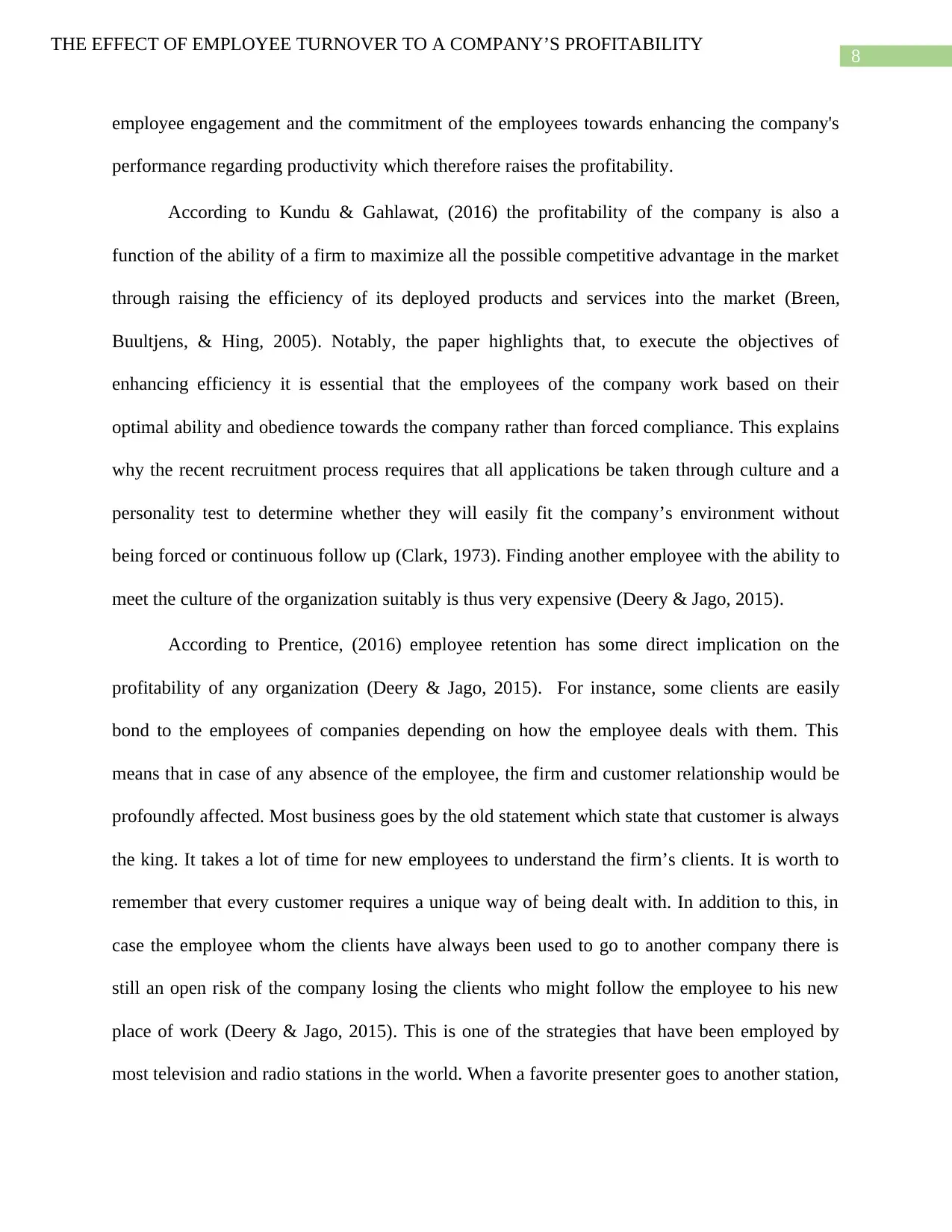
8
THE EFFECT OF EMPLOYEE TURNOVER TO A COMPANY’S PROFITABILITY
employee engagement and the commitment of the employees towards enhancing the company's
performance regarding productivity which therefore raises the profitability.
According to Kundu & Gahlawat, (2016) the profitability of the company is also a
function of the ability of a firm to maximize all the possible competitive advantage in the market
through raising the efficiency of its deployed products and services into the market (Breen,
Buultjens, & Hing, 2005). Notably, the paper highlights that, to execute the objectives of
enhancing efficiency it is essential that the employees of the company work based on their
optimal ability and obedience towards the company rather than forced compliance. This explains
why the recent recruitment process requires that all applications be taken through culture and a
personality test to determine whether they will easily fit the company’s environment without
being forced or continuous follow up (Clark, 1973). Finding another employee with the ability to
meet the culture of the organization suitably is thus very expensive (Deery & Jago, 2015).
According to Prentice, (2016) employee retention has some direct implication on the
profitability of any organization (Deery & Jago, 2015). For instance, some clients are easily
bond to the employees of companies depending on how the employee deals with them. This
means that in case of any absence of the employee, the firm and customer relationship would be
profoundly affected. Most business goes by the old statement which state that customer is always
the king. It takes a lot of time for new employees to understand the firm’s clients. It is worth to
remember that every customer requires a unique way of being dealt with. In addition to this, in
case the employee whom the clients have always been used to go to another company there is
still an open risk of the company losing the clients who might follow the employee to his new
place of work (Deery & Jago, 2015). This is one of the strategies that have been employed by
most television and radio stations in the world. When a favorite presenter goes to another station,
THE EFFECT OF EMPLOYEE TURNOVER TO A COMPANY’S PROFITABILITY
employee engagement and the commitment of the employees towards enhancing the company's
performance regarding productivity which therefore raises the profitability.
According to Kundu & Gahlawat, (2016) the profitability of the company is also a
function of the ability of a firm to maximize all the possible competitive advantage in the market
through raising the efficiency of its deployed products and services into the market (Breen,
Buultjens, & Hing, 2005). Notably, the paper highlights that, to execute the objectives of
enhancing efficiency it is essential that the employees of the company work based on their
optimal ability and obedience towards the company rather than forced compliance. This explains
why the recent recruitment process requires that all applications be taken through culture and a
personality test to determine whether they will easily fit the company’s environment without
being forced or continuous follow up (Clark, 1973). Finding another employee with the ability to
meet the culture of the organization suitably is thus very expensive (Deery & Jago, 2015).
According to Prentice, (2016) employee retention has some direct implication on the
profitability of any organization (Deery & Jago, 2015). For instance, some clients are easily
bond to the employees of companies depending on how the employee deals with them. This
means that in case of any absence of the employee, the firm and customer relationship would be
profoundly affected. Most business goes by the old statement which state that customer is always
the king. It takes a lot of time for new employees to understand the firm’s clients. It is worth to
remember that every customer requires a unique way of being dealt with. In addition to this, in
case the employee whom the clients have always been used to go to another company there is
still an open risk of the company losing the clients who might follow the employee to his new
place of work (Deery & Jago, 2015). This is one of the strategies that have been employed by
most television and radio stations in the world. When a favorite presenter goes to another station,
⊘ This is a preview!⊘
Do you want full access?
Subscribe today to unlock all pages.

Trusted by 1+ million students worldwide
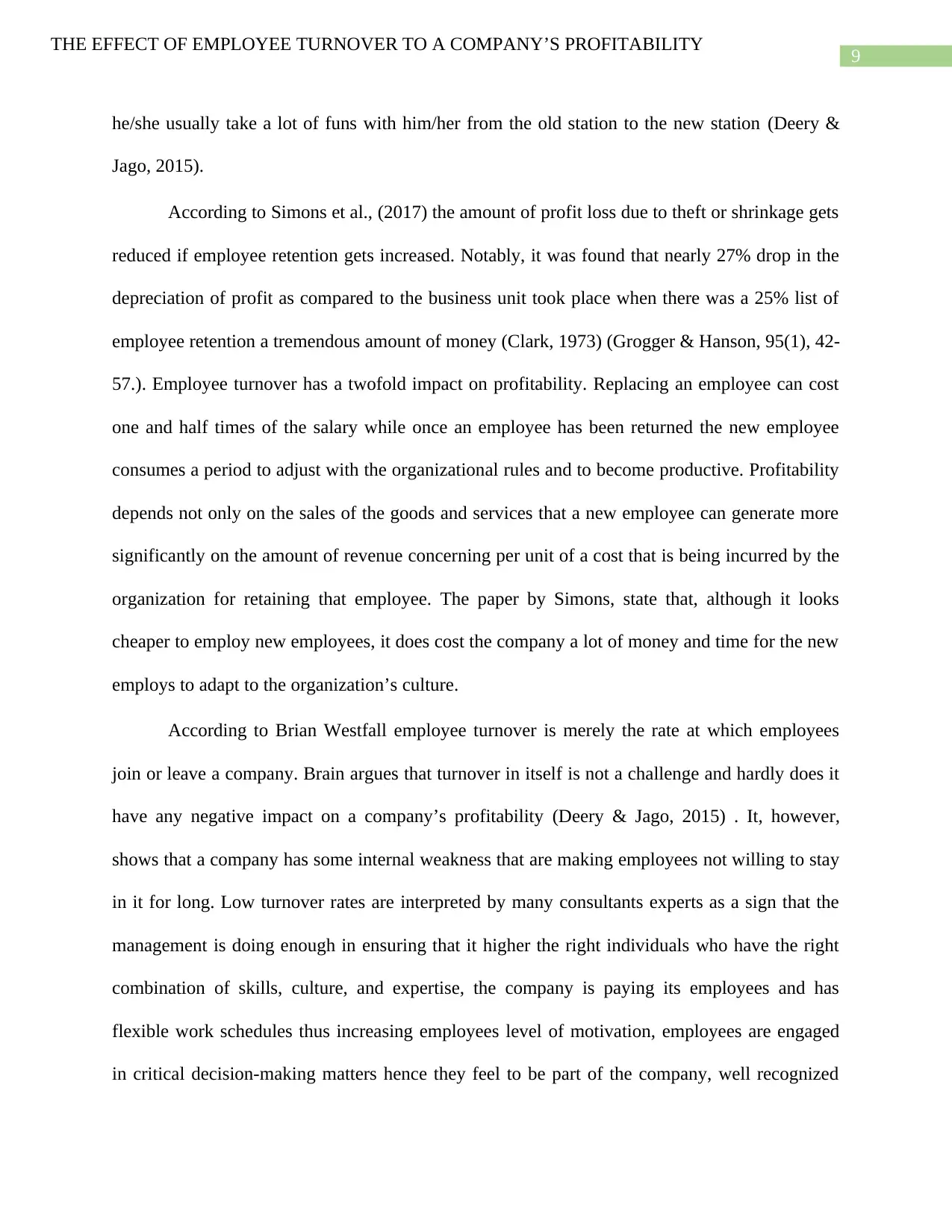
9
THE EFFECT OF EMPLOYEE TURNOVER TO A COMPANY’S PROFITABILITY
he/she usually take a lot of funs with him/her from the old station to the new station (Deery &
Jago, 2015).
According to Simons et al., (2017) the amount of profit loss due to theft or shrinkage gets
reduced if employee retention gets increased. Notably, it was found that nearly 27% drop in the
depreciation of profit as compared to the business unit took place when there was a 25% list of
employee retention a tremendous amount of money (Clark, 1973) (Grogger & Hanson, 95(1), 42-
57.). Employee turnover has a twofold impact on profitability. Replacing an employee can cost
one and half times of the salary while once an employee has been returned the new employee
consumes a period to adjust with the organizational rules and to become productive. Profitability
depends not only on the sales of the goods and services that a new employee can generate more
significantly on the amount of revenue concerning per unit of a cost that is being incurred by the
organization for retaining that employee. The paper by Simons, state that, although it looks
cheaper to employ new employees, it does cost the company a lot of money and time for the new
employs to adapt to the organization’s culture.
According to Brian Westfall employee turnover is merely the rate at which employees
join or leave a company. Brain argues that turnover in itself is not a challenge and hardly does it
have any negative impact on a company’s profitability (Deery & Jago, 2015) . It, however,
shows that a company has some internal weakness that are making employees not willing to stay
in it for long. Low turnover rates are interpreted by many consultants experts as a sign that the
management is doing enough in ensuring that it higher the right individuals who have the right
combination of skills, culture, and expertise, the company is paying its employees and has
flexible work schedules thus increasing employees level of motivation, employees are engaged
in critical decision-making matters hence they feel to be part of the company, well recognized
THE EFFECT OF EMPLOYEE TURNOVER TO A COMPANY’S PROFITABILITY
he/she usually take a lot of funs with him/her from the old station to the new station (Deery &
Jago, 2015).
According to Simons et al., (2017) the amount of profit loss due to theft or shrinkage gets
reduced if employee retention gets increased. Notably, it was found that nearly 27% drop in the
depreciation of profit as compared to the business unit took place when there was a 25% list of
employee retention a tremendous amount of money (Clark, 1973) (Grogger & Hanson, 95(1), 42-
57.). Employee turnover has a twofold impact on profitability. Replacing an employee can cost
one and half times of the salary while once an employee has been returned the new employee
consumes a period to adjust with the organizational rules and to become productive. Profitability
depends not only on the sales of the goods and services that a new employee can generate more
significantly on the amount of revenue concerning per unit of a cost that is being incurred by the
organization for retaining that employee. The paper by Simons, state that, although it looks
cheaper to employ new employees, it does cost the company a lot of money and time for the new
employs to adapt to the organization’s culture.
According to Brian Westfall employee turnover is merely the rate at which employees
join or leave a company. Brain argues that turnover in itself is not a challenge and hardly does it
have any negative impact on a company’s profitability (Deery & Jago, 2015) . It, however,
shows that a company has some internal weakness that are making employees not willing to stay
in it for long. Low turnover rates are interpreted by many consultants experts as a sign that the
management is doing enough in ensuring that it higher the right individuals who have the right
combination of skills, culture, and expertise, the company is paying its employees and has
flexible work schedules thus increasing employees level of motivation, employees are engaged
in critical decision-making matters hence they feel to be part of the company, well recognized
Paraphrase This Document
Need a fresh take? Get an instant paraphrase of this document with our AI Paraphraser
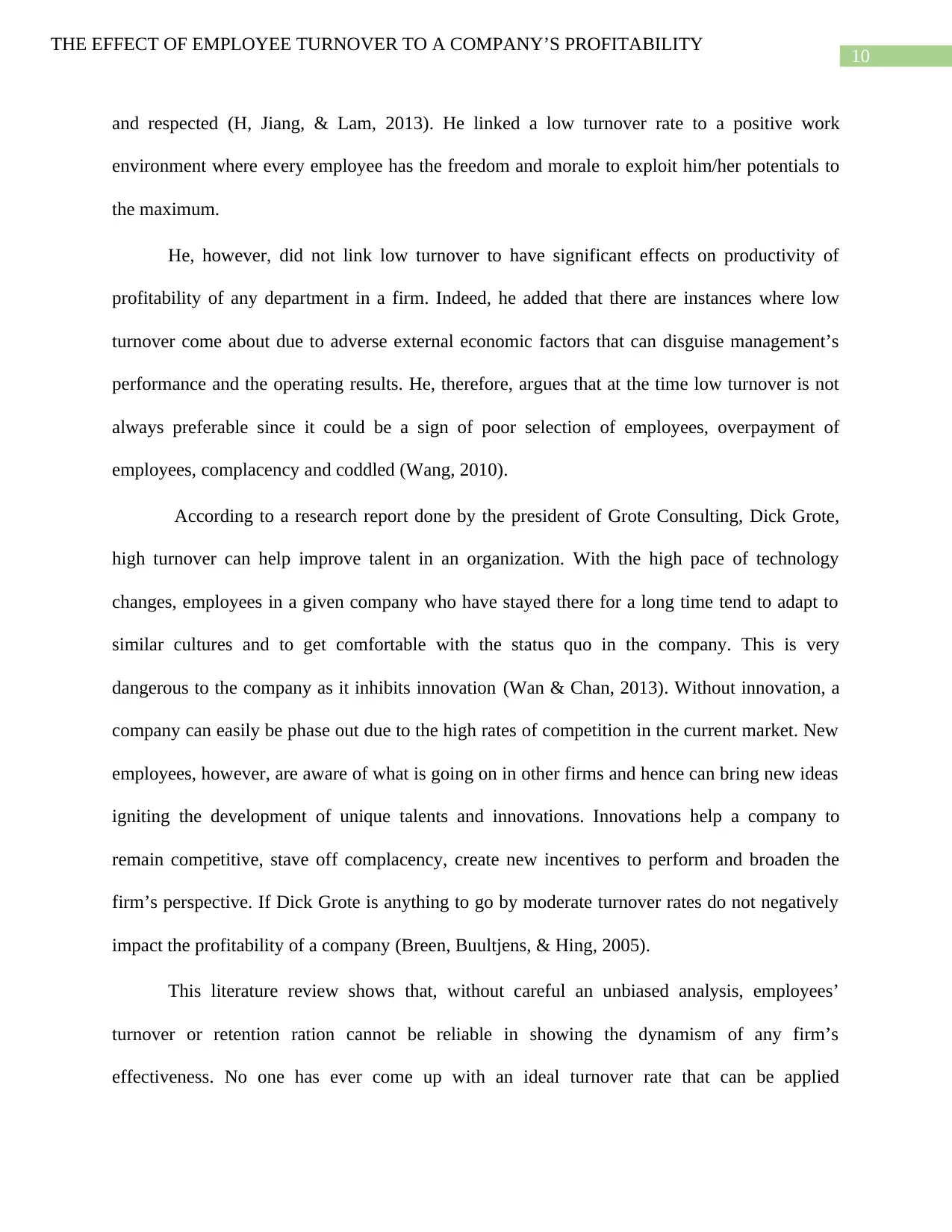
10
THE EFFECT OF EMPLOYEE TURNOVER TO A COMPANY’S PROFITABILITY
and respected (H, Jiang, & Lam, 2013). He linked a low turnover rate to a positive work
environment where every employee has the freedom and morale to exploit him/her potentials to
the maximum.
He, however, did not link low turnover to have significant effects on productivity of
profitability of any department in a firm. Indeed, he added that there are instances where low
turnover come about due to adverse external economic factors that can disguise management’s
performance and the operating results. He, therefore, argues that at the time low turnover is not
always preferable since it could be a sign of poor selection of employees, overpayment of
employees, complacency and coddled (Wang, 2010).
According to a research report done by the president of Grote Consulting, Dick Grote,
high turnover can help improve talent in an organization. With the high pace of technology
changes, employees in a given company who have stayed there for a long time tend to adapt to
similar cultures and to get comfortable with the status quo in the company. This is very
dangerous to the company as it inhibits innovation (Wan & Chan, 2013). Without innovation, a
company can easily be phase out due to the high rates of competition in the current market. New
employees, however, are aware of what is going on in other firms and hence can bring new ideas
igniting the development of unique talents and innovations. Innovations help a company to
remain competitive, stave off complacency, create new incentives to perform and broaden the
firm’s perspective. If Dick Grote is anything to go by moderate turnover rates do not negatively
impact the profitability of a company (Breen, Buultjens, & Hing, 2005).
This literature review shows that, without careful an unbiased analysis, employees’
turnover or retention ration cannot be reliable in showing the dynamism of any firm’s
effectiveness. No one has ever come up with an ideal turnover rate that can be applied
THE EFFECT OF EMPLOYEE TURNOVER TO A COMPANY’S PROFITABILITY
and respected (H, Jiang, & Lam, 2013). He linked a low turnover rate to a positive work
environment where every employee has the freedom and morale to exploit him/her potentials to
the maximum.
He, however, did not link low turnover to have significant effects on productivity of
profitability of any department in a firm. Indeed, he added that there are instances where low
turnover come about due to adverse external economic factors that can disguise management’s
performance and the operating results. He, therefore, argues that at the time low turnover is not
always preferable since it could be a sign of poor selection of employees, overpayment of
employees, complacency and coddled (Wang, 2010).
According to a research report done by the president of Grote Consulting, Dick Grote,
high turnover can help improve talent in an organization. With the high pace of technology
changes, employees in a given company who have stayed there for a long time tend to adapt to
similar cultures and to get comfortable with the status quo in the company. This is very
dangerous to the company as it inhibits innovation (Wan & Chan, 2013). Without innovation, a
company can easily be phase out due to the high rates of competition in the current market. New
employees, however, are aware of what is going on in other firms and hence can bring new ideas
igniting the development of unique talents and innovations. Innovations help a company to
remain competitive, stave off complacency, create new incentives to perform and broaden the
firm’s perspective. If Dick Grote is anything to go by moderate turnover rates do not negatively
impact the profitability of a company (Breen, Buultjens, & Hing, 2005).
This literature review shows that, without careful an unbiased analysis, employees’
turnover or retention ration cannot be reliable in showing the dynamism of any firm’s
effectiveness. No one has ever come up with an ideal turnover rate that can be applied
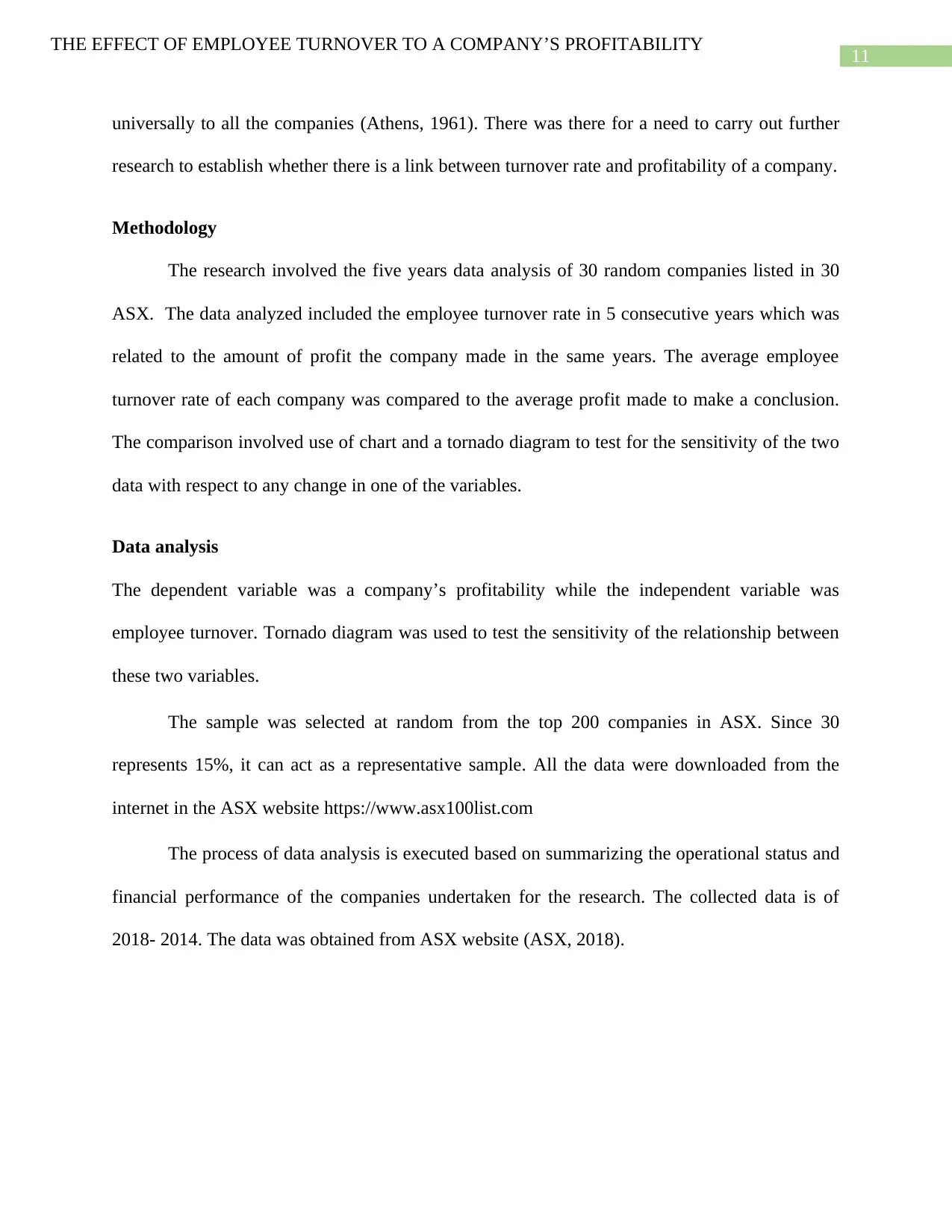
11
THE EFFECT OF EMPLOYEE TURNOVER TO A COMPANY’S PROFITABILITY
universally to all the companies (Athens, 1961). There was there for a need to carry out further
research to establish whether there is a link between turnover rate and profitability of a company.
Methodology
The research involved the five years data analysis of 30 random companies listed in 30
ASX. The data analyzed included the employee turnover rate in 5 consecutive years which was
related to the amount of profit the company made in the same years. The average employee
turnover rate of each company was compared to the average profit made to make a conclusion.
The comparison involved use of chart and a tornado diagram to test for the sensitivity of the two
data with respect to any change in one of the variables.
Data analysis
The dependent variable was a company’s profitability while the independent variable was
employee turnover. Tornado diagram was used to test the sensitivity of the relationship between
these two variables.
The sample was selected at random from the top 200 companies in ASX. Since 30
represents 15%, it can act as a representative sample. All the data were downloaded from the
internet in the ASX website https://www.asx100list.com
The process of data analysis is executed based on summarizing the operational status and
financial performance of the companies undertaken for the research. The collected data is of
2018- 2014. The data was obtained from ASX website (ASX, 2018).
THE EFFECT OF EMPLOYEE TURNOVER TO A COMPANY’S PROFITABILITY
universally to all the companies (Athens, 1961). There was there for a need to carry out further
research to establish whether there is a link between turnover rate and profitability of a company.
Methodology
The research involved the five years data analysis of 30 random companies listed in 30
ASX. The data analyzed included the employee turnover rate in 5 consecutive years which was
related to the amount of profit the company made in the same years. The average employee
turnover rate of each company was compared to the average profit made to make a conclusion.
The comparison involved use of chart and a tornado diagram to test for the sensitivity of the two
data with respect to any change in one of the variables.
Data analysis
The dependent variable was a company’s profitability while the independent variable was
employee turnover. Tornado diagram was used to test the sensitivity of the relationship between
these two variables.
The sample was selected at random from the top 200 companies in ASX. Since 30
represents 15%, it can act as a representative sample. All the data were downloaded from the
internet in the ASX website https://www.asx100list.com
The process of data analysis is executed based on summarizing the operational status and
financial performance of the companies undertaken for the research. The collected data is of
2018- 2014. The data was obtained from ASX website (ASX, 2018).
⊘ This is a preview!⊘
Do you want full access?
Subscribe today to unlock all pages.

Trusted by 1+ million students worldwide
1 out of 31
Related Documents
Your All-in-One AI-Powered Toolkit for Academic Success.
+13062052269
info@desklib.com
Available 24*7 on WhatsApp / Email
![[object Object]](/_next/static/media/star-bottom.7253800d.svg)
Unlock your academic potential
Copyright © 2020–2025 A2Z Services. All Rights Reserved. Developed and managed by ZUCOL.




